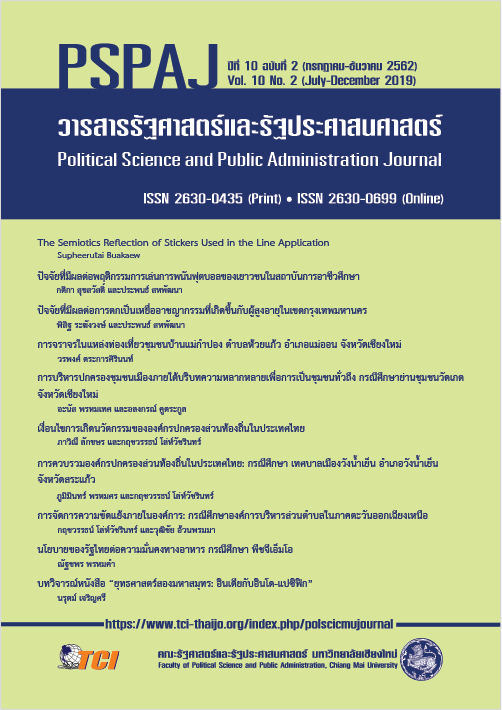The Traffic in Ban Mae Kampong Community-Based Tourism, Huay Kaew Sub-district, Mae On District, Chiang Mai Province
Main Article Content
Abstract
The research was a qualitative research. The purposes of this research were (1) to study the traffic problems in Ban Mae Kampong Community and (2) to study factors affecting traffic conditions in Ban Mae Kampong Community. This study was conducted in both document and field studies. The tools used in the study were: (1) In-depth interviews (2) group discussions and (3) non-participant observation. The data were presented in descriptive analysis. The study revealed that Ban Mae Kampong Community was a village with natural and abundant forest. The community was located in the highlands which had a cool climate all year. People in this community had a unique way of life and culture including houses, dress, traditions and Pa Miang culture, hence the community became famous ecotourism destination. Ban Mae Kampong Community was promoted through various media and the number of tourists increased rapidly from 2,780 persons in 2006-2011 to 7,585 persons in 2012-2016. While most of the tourists were travelling by car, this caused traffic and accident problems. The factors affecting the traffic problems can be divided into 3 aspects: (1) physical factors of the community (2) factors of tourist behavior and (3) policy factors of the concerned agencies.
Article Details
- เนื้อหาและข้อมูลที่ลงตีพิมพ์ในวารสารรัฐศาสตร์และรัฐประศาสนศาสตร์ถือเป็นข้อคิดเห็นและความรับผิดชอบของผู้เขียนบทความโดยตรง ซึ่งกองบรรณาธิการวารสารรัฐศาสตร์และรัฐประศาสนศาสตร์ ไม่จำเป็นต้องเห็นด้วย หรือร่วมรับผิดชอบใดๆ
- บทความและข้อมูล ที่ได้รับการตีพิมพ์ในวารสารรัฐศาสตร์และรัฐประศาสนศาสตร์ ถือเป็นลิขสิทธิ์ของวารสาร หากบุคคลหรือหน่วยงานใดต้องการนำข้อมูลไปใช้ประโยชน์ในทางวิชาการ ขอให้อ้างอิงแหล่งที่มาด้วย
References
เศรษฐกิจการท่องเที่ยวและกีฬา. (2559). รายงานภาวะเศรษฐกิจการท่องเที่ยว. กรุงเทพฯ: กระทรวงการท่องเที่ยวและกีฬา.
โกเมน กันตวธีระ, อารีย์ นัยพินิจ, และธงพล พรหมสาขา ณ สกลนคร. (2556). ปัญหาและอุปสรรคที่ส่งผลต่อการจัดการท่องเที่ยวเมืองขอนแก่น. ใน การประชุมหาดใหญ่วิชาการ ครั้งที่ 4 วันที่ 10 พฤษภาคม 2556, มหาวิทยาลัยหาดใหญ่.
คณะกรรมการหมู่บ้านแม่กำปอง. (2560). กฎระเบียบหมู่บ้านแม่กำปอง หมู่ 3 ตำบลห้วยแก้ว อำเภอแม่ออน จังหวัดเชียงใหม่. เชียงใหม่: ชุมชนบ้านแม่กำปอง.
ฉันทัช วรรณถนอม. (2552). อุตสาหกรรมการท่องเที่ยว. กรุงเทพฯ: สามลดา.
ธนชัย แสงจันทร์. (2558). ทาง (เลือก) รอด การท่องเที่ยวเชิงนิเวศ “แม่กำปอง”. สืบค้นเมื่อ 29 พฤษภาคม 2560, จาก https://www.komchadluek.net/news/edu-health/218452
ธีรชัย ธาราสุข. (2557). บ้านแม่กําปอง เชียงใหม่. สืบค้นเมื่อ 29 พฤษภาคม 2560, จาก https://travel.mthai.com/region/north/75101.html
พรหมมินทร์ พวงมาลา, ถนัด คำก้อน, จำรัส ไทยสมุทร, สุเทพ กิติคุณ, แก้ว กิ่งแก้ว, สุรพล กิ่งแก้ว, และคณะ. (2548). รูปแบบการจัดการแหล่งท่องเที่ยวเชิงอนุรักษ์แบบยั่งยืน บ้านแม่กำปอง กิ่งอำเภอแม่ออน จังหวัดเชียงใหม่. กรุงเทพฯ: สำนักงานกองทุนสนับสนุนการวิจัย.
เมธี ปิยะคุณ. (2557). นำท่องเที่ยวไทยสู่ AEC. สืบค้นเมื่อ 29 พฤษภาคม 2560, จาก https://www.stou.ac.th/study/sumrit/4-60/page1-4-60.html
วิภา ศรีระทุ. (2551). ศักยภาพแหล่งท่องเที่ยวเชิงนิเวศในอำเภอเขาค้อ จังหวัดเพชรบูรณ์. (สารนิพนธ์วิทยาศาสตรมหาบัณฑิต), มหาวิทยาลัยศรีนครินทรวิโรฒ.
ศวิตา สุขสวัสดิ์. (2558). สัมผัสวิถีเรียบง่าย พักผ่อนเอนกายที่แม่กำปอง. สืบค้นเมื่อ 29 พฤษภาคม 2560, จาก https://www.prachachat.net/news_detail.php?newsid=1450323619
ศิรินันทน์ พงษ์นิรันดร, โอชัญญา บัวธรรม, และชัชชญา ยอดสุวรรณ. (2559). แนวทางในการพัฒนาศักยภาพการจัดการท่องเที่ยว อำเภอวังน้ำเขียว จังหวัดนครราชสีมา. วารสารวิทยาลัยบัณฑิตศึกษาการจัดการ มหาวิทยาลัยขอนแก่น, 9(1), 234-259.
ศูนย์ข้อมูลอุบัติเหตุ. (2561). ข้อมูลจำนวนผู้เสียชีวิตและบาดเจ็บ. สืบค้นเมื่อ 16 ตุลาคม 2561, จาก https://www.thairsc.com/
อานันท์ กาญจนพันธุ์, ธเนศวร์ เจริญเมือง, วรพงศ์ ตระการศิรินนท์, ชาติชาย โขนงนุช, และวลีรัตน์ แสงไชย. (2560). ภูมิปัญญาและคุณค่าของเมี่ยงในล้านนา. เชียงใหม่: ศูนย์บริหารงานวิจัย มหาวิทยาลัยเชียงใหม่.

